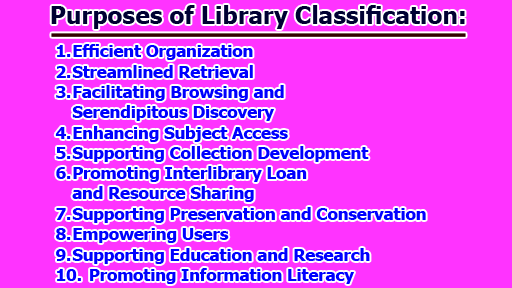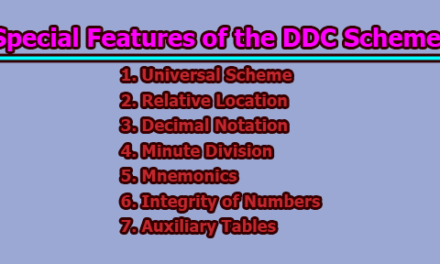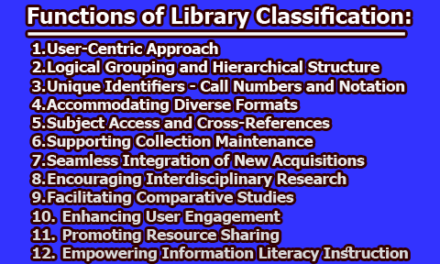Purposes of Library Classification:
Library classification systems play a vital role in organizing and managing the vast array of resources housed in libraries. These systems serve multiple purposes, all aimed at optimizing information organization, enabling seamless access to knowledge, and supporting the needs of library users. Let’s explore the various purposes of library classification:
1. Efficient Organization: The primary purpose of library classification is to establish a logical and systematic arrangement of resources. This ensures that each item finds its designated place on the library shelves, creating a cohesive and organized collection. By categorizing materials based on their subject content, format, or other defining attributes, library classification provides a structured framework for storing and retrieving resources.
2. Streamlined Retrieval: Library classification assigns unique call numbers, codes, or identifiers to each resource. These alphanumeric labels serve as addresses for items, guiding users to their specific location on the shelves. When patrons need to access a particular book, journal, or multimedia item, they can simply consult the catalog, note the call number, and quickly find the resource within the library’s physical layout. This streamlined retrieval process saves time and effort for both library staff and users.
3. Facilitating Browsing and Serendipitous Discovery: While electronic catalogs and search engines have revolutionized information retrieval, the concept of browsing remains an integral part of the library experience. Library classification enables related materials to be grouped together on the shelves, promoting serendipitous discovery. Users browsing a specific section might encounter valuable resources related to their interests that they may not have considered searching for explicitly, enriching their knowledge exploration.
4. Enhancing Subject Access: Library classification creates subject access points, making it easier for users to explore topics of interest comprehensively. Resources on similar subjects are grouped together, allowing users to find related books, journals, or multimedia materials without having to rely solely on searching specific keywords. This enhances the users’ ability to discover a broader range of resources related to their interests.
5. Supporting Collection Development: Library classification aids librarians in assessing the strengths and weaknesses of the library’s collection. By identifying subject areas with significant holdings and others with limited resources, librarians can make informed decisions when developing and expanding the collection. This ensures that the library meets the informational needs and demands of its users, aligning with the mission and goals of the institution.
6. Promoting Interlibrary Loan and Resource Sharing: Library classification systems follow standardized and widely accepted schemes such as Dewey Decimal Classification (DDC) or Library of Congress Classification (LCC). This uniformity allows for seamless communication and cooperation between libraries, making interlibrary loan and resource sharing among different institutions more efficient and effective. Users can access resources beyond their local library, expanding their research capabilities.
7. Supporting Preservation and Conservation: Proper organization through classification ensures that library materials are handled with care and returned to their designated places after use. This practice contributes to the preservation and conservation of valuable resources, extending their usability for future generations. By maintaining the integrity of the collection, classification helps libraries safeguard their cultural and intellectual heritage.
8. Empowering Users: Library classification empowers users to navigate the library’s resources independently. When patrons can easily locate materials on their own, they feel more confident in using the library’s facilities and may explore topics beyond their initial interests, fostering a lifelong love of learning. Empowered users are more likely to utilize the library’s resources to their fullest potential.
9. Supporting Education and Research: Academic libraries, in particular, use subject classification to support various fields of study and research areas. By organizing resources in a coherent manner, classification systems enable students and researchers to access relevant materials efficiently, enriching their academic endeavors and contributing to the advancement of knowledge in their respective disciplines.
10. Promoting Information Literacy: Library classification indirectly promotes information literacy by teaching users how to navigate through a structured system of knowledge. Understanding how classification systems work empowers individuals to search for, evaluate, and use information effectively and ethically. This skill set is essential in today’s information-rich society, where critical thinking and discernment are vital in accessing reliable and credible information.
From the above discussion, we can say that library classification serves as the backbone of effective knowledge organization in libraries. Its multifaceted purposes encompass efficient organization, streamlined retrieval, and supporting both browsing and serendipitous discovery. By enhancing subject access, supporting collection development, and promoting interlibrary cooperation, classification systems ensure libraries remain invaluable hubs of knowledge and learning. Furthermore, classification empowers users, supports education and research, and promotes information literacy, making it a fundamental tool in the modern information age.

Assistant Teacher at Zinzira Pir Mohammad Pilot School and College










